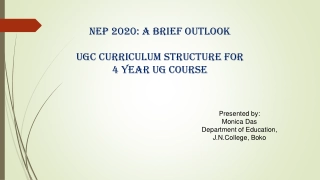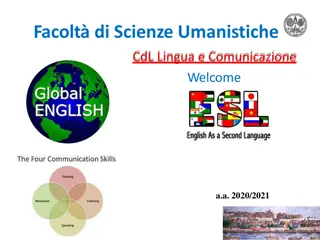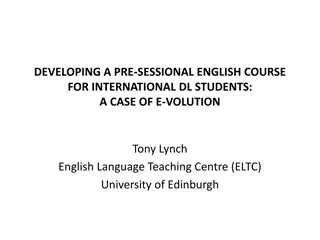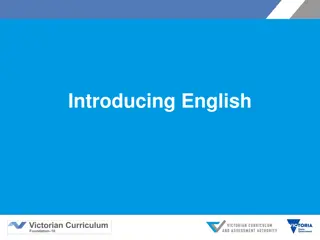Enhancing Language Learning Across the Curriculum in B.Ed. 1st Year Course
Language Across the Curriculum (LAC) emphasizes that language learning should occur across all subjects, not just in language classrooms. It highlights the importance of incorporating language development into every learning activity, fostering multilingualism in schools. Language plays a crucial role in comprehension and knowledge utilization, serving as a medium for exchange of ideas. By integrating language skills into all subjects, teachers can enhance students' understanding and critical thinking abilities.
Download Presentation

Please find below an Image/Link to download the presentation.
The content on the website is provided AS IS for your information and personal use only. It may not be sold, licensed, or shared on other websites without obtaining consent from the author. Download presentation by click this link. If you encounter any issues during the download, it is possible that the publisher has removed the file from their server.
E N D
Presentation Transcript
B.Ed.-1styear Course 4 Language Across The Curriculum By Dr Monawwar Jahan Principal, WTC. P.U.
Language Across the Curriculum Language Across Curriculum is a modern approach that language learning should be occurred throughout the school hours either in language classrooms as well as other subject classrooms. LAC acknowledges that language education does not only take place in specific subjects, but language learning also takes place in each and every subject; in every learning activity; and across the whole curriculum.
Language Across the Curriculum Language learning and education also take place in each and every subject in school, in each and every academic/mental activity, across the whole curriculum whether we are conscious of it or not. For some topics, students should be encouraged to consult books or talk to people in different languages, or gather material in English from the Internet. Such a policy of languages across the curriculum will foster a genuine multilingualism in the school.
Language Across the Curriculum LAC emphasizes that language development is the responsibility of all teachers across the school and in all subject areas. Language education is not confined to the language classroom. A science, social science or mathematics class is ipso facto a language class. Learning the subject means learning the terminology, understanding the concepts, and being able to discuss and write about them critically.
Role and importance of language in the curriculum In the context of curriculum Language is important for comprehension and for making use of knowledge. In the process of exchange of ideas between the teacher and the student, or among the students, language is the chief medium. Language plays very important role in the process of transaction of curriculum.
Role and importance of language in the curriculum Language is always believed to play a central role in learning. No matter what the subject area, students assimilate new concepts when they listen, talk, read and write about what they are learning. Speaking and writing reflects the thinking process that is taking place. Teacher will improve the students results in all subjects, by explicitly teaching students how to write in exams.
Language helps the learners to improve their communication skill. to learn the content more effectively. to expand their ideas. to discuss different issues. to collect technical terms related to different subjects. to submit original assignments free of plagiarism. getting admitted in foreign universities. it facilitates effective self study and refer erring. it opens a vast career world before the students.
Language is center of education To achieve excellence in education we must recognize the centrality of language. It is essential fact that language is what makes humanity a unique species. All students should be required to master the written and the spoken word. Language is the connecting tissue which binds us all together.
Role of language It is obvious that languages plays an important role in various aspects of our daily lives. Their role is not only limited to communication, rather it extends into the vast branches of knowledge and human sciences. Languages are capable of developing human knowledge and extending it for the benefit of human kind.
Role of language Language is more than communication skills Language is also linked to the thinking process Language is a tool for conceptualizing, for thinking, for networking Language supports mental activity and cognitive precision Language for academic purposes helps to express thoughts more clearly (this is especially true for writing) Language helps to structure discourse and practice discourse functions.
There are two basic and intertwining principles behind LAC 1. Language is central to learning. Learning involves language not just as a passive medium for instruction but as the principal means of forming and handling new concepts. 2. Learning (also language learning) is most successful in a meaningful context. In the LAC classroom the emphasis moves away from language as the subject to be studied and is placed on content and process in short on knowledge, knowledge in a scientific or mathematical or geographical or historical or musical or artistic context. The language used in search of this knowledge becomes a tool .
According to Vygotsky Vygotsky "viewed intelligence as the capacity to benefit from instruction, with language having a powerful developmental role" (Spencer, 1988, p. 170). In this sense, language is a tool for learning and an aid to understanding. Writes Vygotsky (1978), "human learning pre supposes a specific social nature and a process by which children grow into the intellectual life of those around them" (p. 88). As such, language acts as a vehicle for educational development and is important for the apprehension and acquisition of knowledge.
According to Vygotsky Vygotsky (1978) maintained that the zone of proximal development is an "essential feature of learning" (p. 90), in which one builds on one's knowledge through interaction and co-operation with one's peers. In this sense, the authority or teacher in all learning situations acts as a collaborator and coach, in which he or she "provides scaffolding to lead the student to increase understanding" (Hawisher, 1994, p. 44). In this respect, the basis of education is people interacting with other people (Daniels, 1996; Shale, 1988; Shale & Garrison, 1990).
Scaffolding Vygotsky s scaffolding is part of the education concept zone of proximal development or ZPD. The ZPD is the set of skills or knowledge a student can't do on his/her own but can do with the help or guidance of someone else. It's the skill level just above where the student currently is.
Role of teacher Teachers should know that in order to be successful in their subject, students must have good skills in reading and decoding exam questions, as well as the knowledge of how to write answers in ways relevant to the assessment in their subject. Teacher have a structured, monitored and assessed approach to explicitly teaching the language of their subject. Learning outcomes during planning and incorporation into schemes of work, best reflects in language across the curriculum approach.
Four basic skills of language Teacher should be careful for 4 basic skills of language: 1. Listening: comprehending oral input/intake 2. Speaking: constructing meaningful utterances 3. Reading : understanding written texts 4. Writing : producing written texts/coherent discourse Strong language skills are an asset that will promote a lifetime of effective communication.
LAC as curricular enrichment program Languages Across the Curriculum (LAC) is a curricular enrichment program that provides students with the opportunity to use their skills in languages other than in non-language courses.( for ex- Sc.,Soc.Sc etc). LAC offers a different approach to language learning It is based on the developmental and motivational aspects of language learning,
Aspects of language learning The Motivational Aspect The first and main learning phase is when the child learns his or her mother language. The second time is normally in an academic context when the child or young person has to learn a foreign language at school. Usually the question of motivation and motivational problems is only found in the context of the second experience, learning a foreign language:
Aspects of language learning The Motivational Aspect At school the scene changes when the child becomes the student and is expected to learn a foreign language in classroom conditions. For a variety of reasons the motivational drive found in learning the mother language is missing. Apart from an initial period of interest for the new subject the student often fails to see the necessity for learning the particular language. LAC offers such an opportunity to motivate to learning a foreign language is beneficial and meaningful.
Aspects of language learning The Developmental Aspect Trends and theories in language teaching have developed rapidly in the last forty years. The following brief overview plots the course of the development of some of the major theories. Linguistic theory The pre-1960s: up until the 1960s prevalent theories of learning influenced language learning and emphasized the need for the mastery of a set of linguistic structures.
Linguistic theory The 1960s: theories of learning began to change and accordingly affected the perception of language learning. Language was now seen as something out there which could be conquered by developing a pattern of very clear linguistic habits. Since the 1970s: socio-linguistics began to influence theories of language learning and language was seen as something which individuals used for the purpose of communication; communicative competence and the communicative approach become the new cult words.
Aspects of language learning Language Across the Curriculum: based on the developmental and motivational aspects of language learning LAC offers a different approach to language learning.
Aspects of language learning Communicative Aspect Some of the most salient notions of the communicative approach, which have direct relevance for LAC, are as follows: Process rather than product Message rather than medium Learner potential rather than teacher input The information gap
Aspects of language learning The Teaching Aspect Normal teaching: normal kind of language learning with a clear schedule and a course book which follows a very definite language progression. The emphasis is most definitely on language and the acquisition of skills. Normal foreign language teaching is prone to all kinds of motivational pitfalls .
Aspects of language learning The Teaching Aspect Project teaching: often teachers leave aside the course book in order to spend more time on a particular topic of interest (e.g. environment, health, etc.). They develop their own materials so that their pupils can study the topic in the target language. In project teaching the emphasis is on both language and content. This approach certainly raises the level of motivation and encourages students to use language in a meaningful way.
Difference between normal teaching Project teaching and LAC Approach Normal teaching concentrates on language Project teaching concentrates on language and content LAC concentrates on content and process = knowledge (language as a tool)
Milestone: Bullock Report The Bullock Report: to underline this development, Chapter 12 of the Bullock Report A Language for Life (1975) emphasized three essential elements: Language crosses the curriculum Every teacher is therefore by definition a language teacher. Every school should have a (whole) language policy.
Conclusion In short, LAC is a whole-language approach so that children can build up their knowledge of language without specific practice of skills. In this way, language arises with a purpose. LAC is an exciting new way of looking at language learning. Like in all areas of foreign language teaching there should be an eclectic and well balanced approach. In order to do this teachers need the necessary hardware , i.e. Progressive curricula, Appropriate teaching materials.
Function of language Generally, there are five main functions of language, which are Informational Aesthetic Expressive Phatic Directive
Phatic The phatic function of language is that which keeps the channels of communication open. Despite it appearing that content is minimal. It is a function "primarily serving to establish, to prolong, or to discontinue communication" (Jakobson). It is a kind of sociological function as well as a linguistic one. Phatic communication is popularly known as small talk: the non-referential use of language to share feelings or establish a mood of sociability rather than to communicate information or ideas.
7 Functions of language The first four functions help the child to satisfy physical, emotional and social needs. Halliday calls them instrumental, regulatory, interactional, and personal functions. The next three functions are heuristic, imaginative, and representational, all helping the child to come to terms with his or her environment.
Elective meaning - deriving ideas, style, or taste from a broad and diverse range of sources. denoting or belonging to a class of ancient philosophers who did not belong to or found any recognized school of thought but selected doctrines from various schools of thought. a person who derives ideas, style, or taste from a broad and diverse range of sources.
Cult meaning -In modern English, a cult is a social group that is defined by its unusual religious, spiritual, or philosophical beliefs, or by its common interest in a particular personality, object or goal. Pitfall-meaning- a hidden or unsuspected danger or difficulty.























